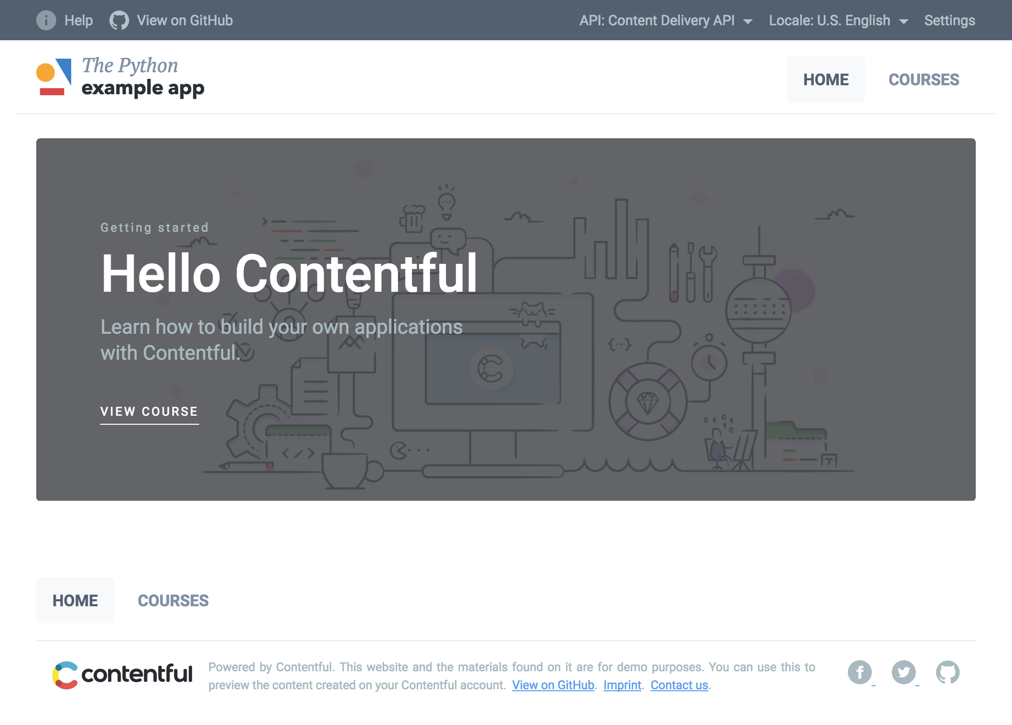Note: This repo is no longer officially maintained as of Jan, 2023. Feel free to use it, fork it and patch it for your own needs.
The Python example app
The Python example app teaches the very basics of how to work with Contentful:
- consume content from the Contentful Delivery and Preview APIs
- model content
- edit content through the Contentful web app
The app demonstrates how decoupling content from its presentation enables greater flexibility and facilitates shipping higher quality software more quickly.
You can see a hosted version of The Python example app on Heroku.
Disclaimer
Please note: this repository is meant as a learning tool for Contentful in a development environment, and is not meant or supported for production use.
What is Contentful?
Contentful provides a content infrastructure for digital teams to power content in websites, apps, and devices. Unlike a CMS, Contentful was built to integrate with the modern software stack. It offers a central hub for structured content, powerful management and delivery APIs, and a customizable web app that enable developers and content creators to ship digital products faster.
Requirements
- Python 2.7+ or 3.3+ (if running tests locally 3.3+ is required)
- Git
- Contentful CLI (only for write access)
Without any changes, this app is connected to a Contentful space with read-only access. To experience the full end-to-end Contentful experience, you need to connect the app to a Contentful space with read and write access. This enables you to see how content editing in the Contentful web app works and how content changes propagate to this app.
Common setup
Clone the repo and install the dependencies.
git clone https://github.com/contentful/the-example-app.py.gitpip install -r requirements.txtSteps for read-only access
To start the server, run the following
make runOpen http://localhost:3000 and take a look around.
Steps for read and write access (recommended)
Step 1: Install the Contentful CLI
Step 2: Login to Contentful through the CLI. It will help you to create a free account if you don't have one already.
contentful loginStep 3: Create a new space
contentful space create --name 'My space for the example app'Step 4: Seed the new space with the content model. Replace the SPACE_ID with the id returned from the create command executed in step 3
contentful space seed -s '<SPACE_ID>' -t the-example-appStep 5: Head to the Contentful web app's API section and grab SPACE_ID, DELIVERY_ACCESS_TOKEN, PREVIEW_ACCESS_TOKEN.
Step 6: Open .env and inject your credentials so it looks like this
APP_ENV=development
CONTENTFUL_SPACE_ID=<SPACE_ID>
CONTENTFUL_DELIVERY_TOKEN=<DELIVERY_ACCESS_TOKEN>
CONTENTFUL_PREVIEW_TOKEN=<PREVIEW_ACCESS_TOKEN>
SESSION_SECRET=someSecretTokenHere
PORT=3000Step 7: To start the server, run the following
make runFinal Step:
Open http://localhost:3000?editorial_features=enabled and take a look around. This URL flag adds an “Edit” button in the app on every editable piece of content which will take you back to Contentful web app where you can make changes. It also adds “Draft” and “Pending Changes” status indicators to all content if relevant.
Deploy to Heroku
You can also deploy this app to Heroku:

